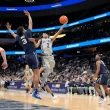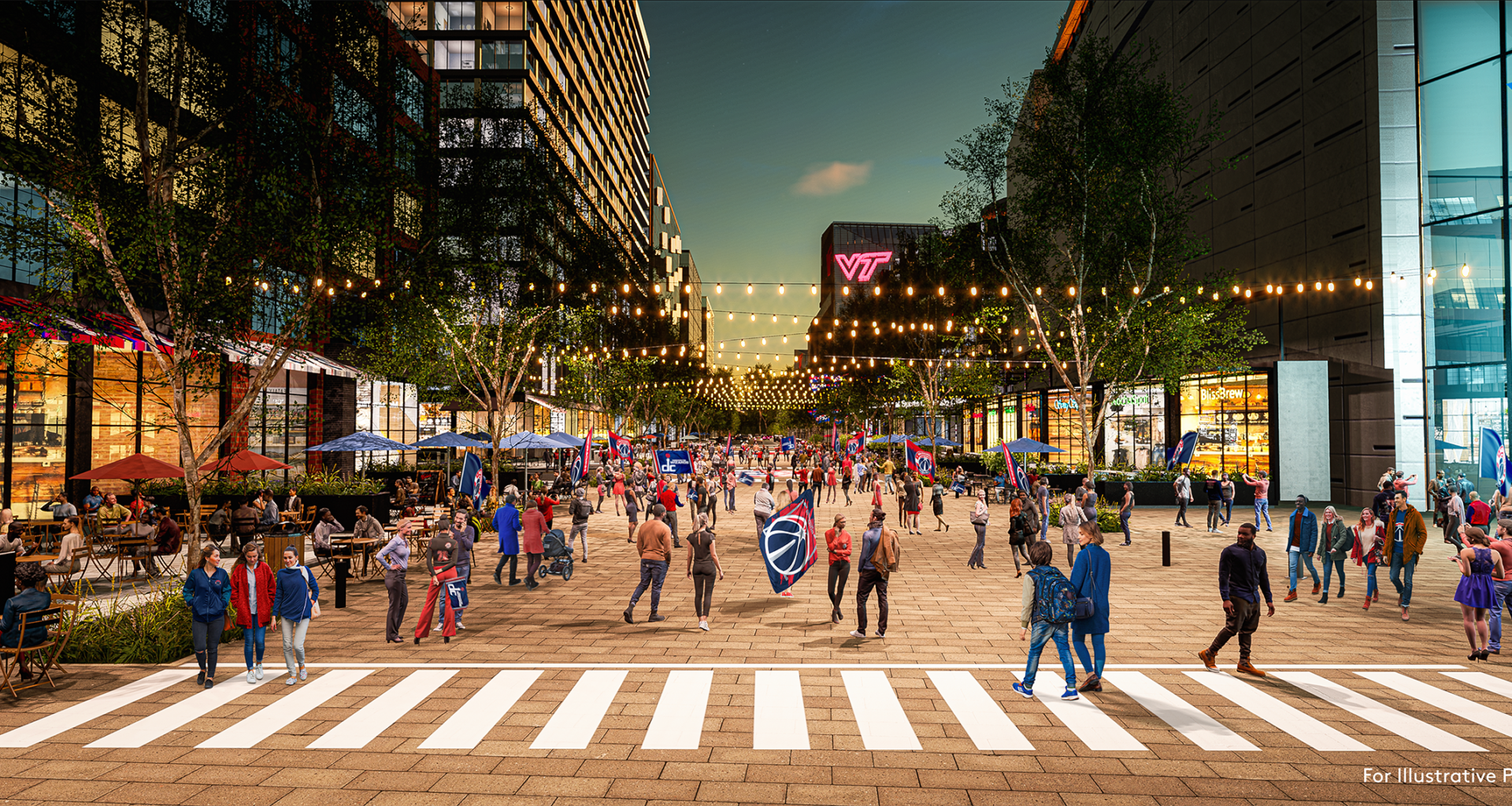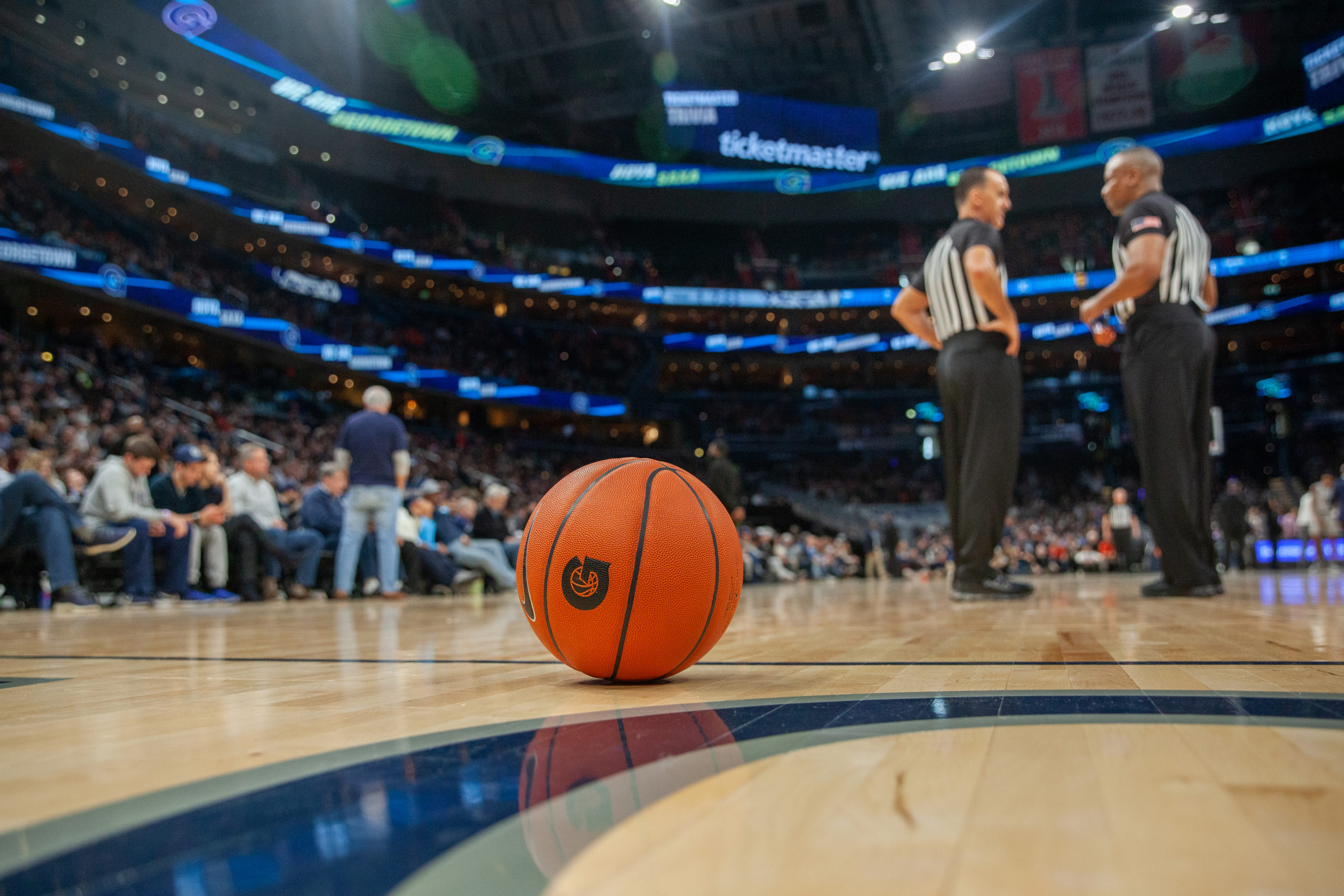Will Georgetown ever get an on-campus arena? What about its own arena somewhere in D.C.? These are seemingly perpetual questions when it comes to Georgetown’s basketball programs. These topics have once again popped up as Monumental Sports & Entertainment owner Ted Leonsis attended a news conference earlier this week with Virginia Governor Glenn Youngkin in Alexandria to unveil plans for a new arena complex and entertainment district for the Washington Wizards and Capitals. Let’s take a comprehensive look at how we’ve gotten to where we currently are, where we’re going, and a whole lot of in-between.
Potomac Yard Plan
Just this past week, Virginia Governor Glenn Youngkin and Monumental Sports and Entertainment owner Ted Leonsis announced at a news conference in Alexandria plans to build a $2 billion sports and entertainment district that will create 30,000 new jobs for the state and be the new home of the Washington Wizards and Capitals, as well as the corporate headquarters for Monumental, set to open in 2028.
The two announced that Monumental and Virginia lawmakers had come to an agreement on a public-private partnership for the Potomac Yard district. The project, which has been approved by Virginia’s Major Employment and Investment Project Approval Commission, tentatively states that Monumental would continue operating Capital One Arena as a “flexible arena” for concerts and Georgetown basketball games, potentially bringing the WNBA’s Washington Mystics back to Capital One Arena from their current home at Entertainment Sports Arena in southeast D.C..
The drive to the newly announced Potomac Yard district is similar to that of a commute to Capital One Arena for students, likely taking anywhere from 20-30 minutes via bus. A Potomac Yard metro stop was just recently built on the Yellow Line, allowing D.C. residents to easily access the district in Potomac Yard. With the complex set to break ground in 2025 and open in 2028, Leonsis told reporters at a news conference on December 13, “When we first came out here and I saw 70 acres and the ability to start with a clean slate and imagine what would an arena 30 years from now need to be built and be served. It really is a very very romantic but also pragmatic vision that we have, that we can’t do anywhere else.”
A statement from Monumental on the news read, “Post-2027, a key component in our strategy for Capital One Arena will be enhancing the arena’s flexibility to adapt the seating capacity to suit various event types, audience sizes, and event dynamics.” As the current wording indicates, it seems that Georgetown would remain in Capital One Arena and would not follow the Wizards and Capitals to the new entertainment district, remaining one of the headlining tenants of the left-behind arena in Chinatown/Gallery Place.
Should Leonsis and Monumental follow through on the commitment they seemingly have already made, Georgetown would be left with the option to remain at Capital One Arena as one of the very few, if only, tenants remaining while continuing to provide free buses to transport students to and from games, or they could inquire about the yearly cost of rent at the new complex at Potomac Yard.
To my understanding, Georgetown’s current rent agreement with Capital One Arena has the school paying over $1 million per year, and that number would likely only be higher should the Hoyas consider a move to the new space in Virginia.
The last issue to consider with a potential move to Potomac Yard is Rocket Bar! Although the newly proposed entertainment district at Potomac Yard would likely feature bars and other watering holes capable of satisfying a raucous crowd after a big game, the move into Alexandria would nevertheless see the end of the postgame Rocket Bar tradition. Such a move would be unfortunate, but I suppose that isn’t really on anyone’s mind when considering where Georgetown will actually play.
Visit www.monumentalalx.com for more information on the vision for the proposed Potomac Yard district.
D.C. Downtown Revitalization Plan (Stay At Capital One Arena)
As some speculated that Leonsis’ move to attend the press conference was merely a bluff to entice D.C. Mayor Bowser to commit district funds to a renovation project to the Chinatown/Gallery Place area, late on December 12, the night prior to the news conference with Youngkin and Leonsis, the Mayor’s office released a plan to do just that. Bowser and the D.C. Council unveiled legislation to support a downtown revitalization and investment into a Capital One Arena modernization project.
In a press release, the Mayor’s office described the proposed revitalization downtown by saying, “The legislation, which has unanimous support from the D.C. Council, outlines the District’s contribution of a half billion dollars to the modernization project to create a state-of-the-art urban arena and solidifies Monumental Sports and Entertainment as an economic anchor of the Gallery Place-Chinatown entertainment district and a destination for District residents and visitors.”
Leonsis had initially sought $600 million from D.C. months ago, with city officials proclaiming their desire to keep the Wizards and Capitals in Chinatown/Gallery Place. “The legislation that Mayor Bowser submitted to the Council outlines the parameters of the agreement, including receiving the authority to enter into a lease extension and provide financing of $500 million toward the $800 million renovation project over a period of three years beginning in 2024. City leaders have also committed to a swift and expedited review and approval process to meet current construction plans for the arena.”
The legislation, ironically enough, proposes the funds from 2024-2027 the year at which Monumental is able to buy out of the bonds and leave D.C. and the Capital One Arena lease, otherwise, they have to stay put until 2047. A slide deck on behalf of the Mayor’s office was put together to show Leonsis how integral Monumental is to the District and what new investments could look like in the downtown area, and that can be found here.
Ultimately, this revitalization, should it happen, would mean the status quo for Georgetown. The University would be a major benefactor of any and all work down in the area to help the gameday experience for students and fans alike, especially as the team begins a new era under Ed Cooley, who the school believes is the right man to steward the program back to newfound glory. Turning the area into more of an entertainment district would allow for fans to spend more time around the arena before and after games, rather than showing up twenty minutes before tip, logging three to four hours at Rocket Bar postgame, and Ubering back to the Georgetown neighborhood. That is to say, there’s nothing wrong with that current sequence of events, but such a revitalization could make the entire experience more enjoyable (though some would argue the Hoyas winning could cure it all).
The Renovate McDonough Plan
My esteemed colleague Bobby Vogel did great work in a piece for Thompson’s Towel back in 2022 that laid out a few options – in extensive detail, I might add – to renovate McDonough Arena into an arena fit for a modern college basketball game rather than the glorified 2,500 seat practice facility it currently is. I say that with all due respect to the Georgetown Women’s Basketball and Volleyball teams, which do not deserve to have to play there either as it currently exists.
As Bobby plainly stated in regards to Georgetown’s current arrangement at Capital One Arena, “Capital One Arena is the fifth largest D1 college basketball arena among 358 schools. Its capacity of 20,356 for basketball games is nearly triple Georgetown’s entire undergraduate population of 7,357. It’s no secret that Georgetown often fails to fill even a quarter of the venue’s seats for home games in the past decade. In fact, the Hoyas only officially averaged 7,931 fans for the 2019-2020 season—the last full season played in front of fans—placing them at 66th in the country (and even that number feels pretty inflated). Georgetown has not had a sellout crowd since the Big East was reconfigured in 2013.”
Bobby’s options included three different ways the University could make McDonough a feasible option to host home games: rotate the court 90 degrees, build a horseshoe-style seating arrangement, or rotate the court 90 degrees and make the bleachers 45 degrees, limiting capacity but allowing for the arena to have space to create a better gameday atmosphere. Bobby went through the time and effort to make extremely clear and precise renderings for his vision, attached below)
The idea of digging down into the pre-existing structure of McDonough also exists, and to my knowledge, McDonough Arena itself cannot be demolished or have the outside of the structure otherwise altered on the outside. This idea was initially floated in 2000 by then-athletic director Joe Lang, who proposed turning the court 90 degrees and digging into the floor to create a “convocation center” worthy of Big East Conference standards. I appreciated AD Lang’s commitment to University-wide vocabulary, careful to not emphasize the athletic purpose it would have served. Lang’s proposal also called for a modern practice facility adjacent to the convocation center, which was the only part of the proposal that survived, known today as the Thompson Athletic Center, a $62 million facility that opened in 2016.
Ultimately, I still think while Bobby’s plans are great, the issue of traffic and accessibility, to say nothing of the facts about the Georgetown community and residents, makes it highly unlikely that such a renovation would ever come to fruition. Let’s keep exploring.
The Key Bridge Marriott Plan
The granddaddy of them all, surprise surprise, it’s The Key Bridge Marriott plan! For those unaware, the Key Bridge Marriott is an abandoned property directly across the Key Bridge from Georgetown’s campus, a literal stone’s throw away. The hotel was closed in 2021 after going under contract for $190M in 2017 to a new owner. The current owner and developer, Woodridge Capital Partners, who had been approved to partially demolish the site to build two new residential buildings, was behind on real estate taxes on the property in 2022. The property was later condemned for health and safety reasons in March 2023, when local police and firefighters arrived on the scene to escort unhoused individuals from the property.
Natalie Roy, who is seeking the Democratic nomination for the Arlington County Board, said at an event, “Arlington County should explore ways to form a private-public partnership to purchase and then re-utilize this prime property. The site could be a showcase for Arlington and include a mixed-use complex that provides affordable housing and retail for essential workers and the most vulnerable members of our community.”
Ultimately, if you follow Georgetown basketball and are at least a semi-active member of Hoya Twitter, you know all about this plan. The idea is to demolish the hotel and replace it with ideally anywhere from a 12k-15k seat multi-purpose arena, finally giving Georgetown a distinctive home-court advantage that is readily accessible to the University’s main campus. A parking garage already exists on-site next to the condemned building, albeit a small one. Additional parking facilities, whether that means building up on the pre-existing garage or attempting to fit another larger garage on the premises, would definitely be necessary.
The Rosslyn metro station is a 0.3-mile walk away from the site, and a bus stop is across the street. Students would be able to walk across the Key Bridge and back, potentially getting rid of an hour-long commute (there and back) to Capital One Arena for every game. A new Georgetown-only arena on the site could house women’s basketball and volleyball games as well, allowing the University to convert McDonough into more athletics facility/office space (it is still sorely needed despite the Thompson Athletic Center expansion).
Cost-wise, in my completely unprofessional and semi-educated opinion, it would likely cost at least $100M to buy the land, demolish the existing buildings, and build an entirely new arena from scratch, my guess is it could cost as much as $250M, though that is purely an estimate and based off of no financial analysis. There is a large range that the University could choose to spend, as Ole Miss recently built a 9,500-seat arena in 2016 that cost an estimated $96.5 million, while UT-Austin’s 15,000-seat Moody Center that opened in 2022 cost an estimated $375 million. A full investment into the Marriott land would likely fall somewhere right in the middle of those two numbers.
The reality of the Key Bridge Marriott facility is that Georgetown, even if it began fundraising tomorrow, likely wouldn’t open the facility at the site for at least a decade, assuming they would want to fully fund the arena’s cost and not use debt service.
Georgetown’s 2017-2036 Campus Plan
As it stands, Georgetown’s Campus Plan from 2017-2036, which is required for all universities in the District of Columbia to anticipate enrollment and development, does not include plans for any further expansion or intercollegiate athletics development.
In plain English, the Campus Plan clearly states that the surrounding Georgetown neighborhood and its residents play a major role in decision-making, saying, “To that end, residents of the neighborhoods surrounding the campus are not only stakeholders but critical partners in this effort – partners who share a strong interest in the continued vitality of the University as well as in ensuring that its impacts are appropriately and effectively minimized and managed.”
Knowing what we have known for years about the community’s disapproval when it comes to an on-campus arena for Georgetown, this excerpt seems to shut the door on renovating McDonough as a possibility, before parking/traffic concerns are even mentioned
Otherwise, the Campus Plan’s only mention of athletics and recreation is its plan to demolish the existing Yates Field House structure and create a replacement facility that could possibly include an outdoor athletic space on the roof (as currently exists in Kehoe Field) and hotel/conference center in support of University and Hospital operations, potentially linking the facility to the Leavey Center (I have no clue how that’s supposed to work, or when that’s supposed to happen.)
The Campus Plan is available in its entirety here
Lack of Donor & Institutional support
A disappointing fact to encounter when considering the litany of options Georgetown has when it comes to potentially moving the host site of its basketball games is this: there is little donor support, and next to no institutional support, as indicated above with the Campus Plan. Unless it is forced to do otherwise, it seems to me that Georgetown is more than happy to stay put in Capital One Arena for the time being. The University would simply hope its new and sizable investment in freshly minted Head Coach Ed Cooley would begin to translate to wins and a resurgent fan base that drives attendance and enthusiasm both among the student body and throughout the greater DMV community.
The University’s large investment in the Thompson Athletic Center took nearly a decade to fully fundraise, and it still barely got there. While I’m not sharing this as a definitive truth or a confirmed report, a HoyaTalk user known as DFW Hoya indicated that Georgetown’s Hariri Building, which houses the McDonough School of Business, was the only building project of the last twenty years to be financed without debt service. To that end, there is no chance the University would be able to fully finance purchasing land such as the Marriott, knock down the pre-existing structure, and rebuild a state-of-the-art college basketball arena. And even if they somehow managed to pull that off, the arena we’re fantasizing over would not physically exist for at least another decade, and even that is being generous.
Backup Options
Ultimately, all of these options and plans leave us with a few burning questions: If Georgetown were to find feasible and affordable land to build an arena, would they even want to buy it? Would they just send coach buses to Potomac Yard instead of Chinatown and continue to pay 7 figures in rent for the new arena? Would they continue playing at the otherwise left-for-dead Capital One Arena? If Monumental abandons Cap One entirely and Georgetown feels that the price of rent at Potomac Yard is too expensive, where do they play?
Entertainment Sports Arena, the current host site of the WNBA’s Washington Mystics, has a capacity of less than 5,000. I have seen a rumor that ESA’s location in Southeast D.C. has proven a huge obstacle in the arena’s attempt to sell naming rights, so that could be an issue to watch there before even factoring in further travel or small capacity. McDonough Arena, with an officially listed capacity of just 2,500, has proven to not be a feasible option for games with little to no parking available and, despite what Providence fans may believe, not enough seating for fans. George Mason’s Eagle Bank Arena, a 10,000-seat arena in Fairfax, Virginia, is a 20-mile drive that can get up to an hour’s commute during peak times. George Washington’s Smith Center has a capacity of 5,000 and underwent a renovation back in 2010-11. None of these, as you are probably thinking, are good options for Georgetown. The doomsday scenario is indeed picking between one of these several poor options, and while I don’t think it’s likely it will ever reach this point, I would be genuinely worried about the University’s dedication to being a committed and competitive member of the Big East conference if it did.
Head Coach Ed Cooley remains a major player in any decision to be made regarding an arena. Cooley naturally took the Georgetown job knowing the situation the Hoyas have at Capital One Arena, but as I mentioned on Twitter, he alone nudging the Board/administration for a nearby arena would not be enough to get the ball rolling. When asked about the subject of Capital One Arena vs. Potomac Yard, Cooley deferred to Georgetown President Jack DeGioia and Athletic Director Lee Reed, saying he enjoys playing at Capital One Arena. Cooley also expressed that he has no desire to play games at McDonough Arena as it currently exists, saying, “That’s not what we came here to do.” Ultimately, such an effort to buy land like the Key Bridge Marriott would need to be direct, comprehensive, and swift, in the sense that it would need several commitments from major donors/alums, it would need to be straight to the office of President DeGioia, and it would need to be soon. Will that happen? Almost certainly not.
Where does this leave us?
So, where does this leave us? I don’t know. My gut tells me that should Capital One Arena shutter, the Hoyas would likely fork over another number in the seven figures annually to call the new complex at Potomac Yard home rather than explore other options. I could be wrong, but hell, that’s why I wrote this article/essay/thesis during my finals week instead of studying.
To be clear, the Key Bridge Marriott arena complex is my dream scenario, and I know I am not alone in that regard, but the likelihood of this ever happening is slimmer than slim. It’s probably not ever going to happen, but until Georgetown officially comes out and says “no,” let a kid dream!








Good read. Brief history lesson fwiw … “a HoyaTalk user named…” is actually “Hoya Talk’s founder …”